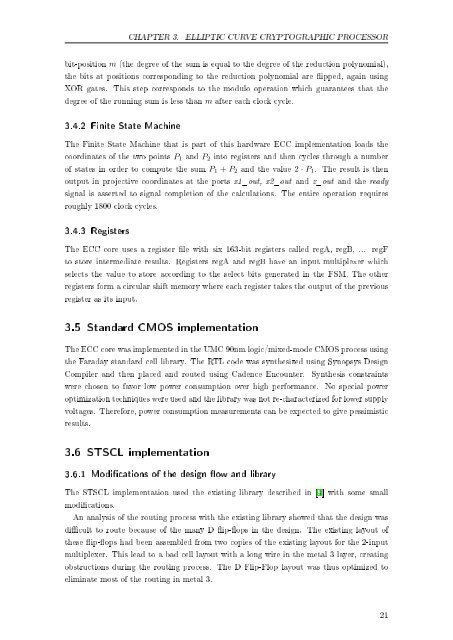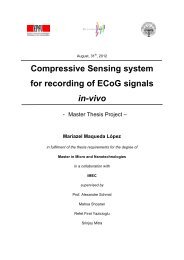Ultra-Low-Power Digital Circuit Design - Microelectronic Systems ...
Ultra-Low-Power Digital Circuit Design - Microelectronic Systems ...
Ultra-Low-Power Digital Circuit Design - Microelectronic Systems ...
- No tags were found...
You also want an ePaper? Increase the reach of your titles
YUMPU automatically turns print PDFs into web optimized ePapers that Google loves.
CHAPTER 3.ELLIPTIC CURVE CRYPTOGRAPHIC PROCESSORbit-position m (the degree of the sum is equal to the degree of the reduction polynomial),the bits at positions corresponding to the reduction polynomial are ipped, again usingXOR gates. This step corresponds to the modulo operation which guarantees that thedegree of the running sum is less than m after each clock cycle.3.4.2 Finite State MachineThe Finite State Machine that is part of this hardware ECC implementation loads thecoordinates of the two points P 1 and P 2 into registers and then cycles through a numberof states in order to compute the sum P 1 + P 2 and the value 2 · P 1 . The result is thenoutput in projective coordinates at the ports x1_out, x2_out and z_out and the readysignal is asserted to signal completion of the calculations. The entire operation requiresroughly 1800 clock cycles.3.4.3 RegistersThe ECC core uses a register le with six 163-bit registers called regA, regB, ... regFto store intermediate results. Registers regA and regB have an input multiplexer whichselects the value to store according to the select bits generated in the FSM. The otherregisters form a circular shift memory where each register takes the output of the previousregister as its input.3.5 Standard CMOS implementationThe ECC core was implemented in the UMC 90nm logic/mixed-mode CMOS process usingthe Faraday standard cell library. The RTL code was synthesized using Synopsys <strong>Design</strong>Compiler and then placed and routed using Cadence Encounter. Synthesis constraintswere chosen to favor low power consumption over high performance. No special poweroptimization techniques were used and the library was not re-characterized for lower supplyvoltages. Therefore, power consumption measurements can be expected to give pessimisticresults.3.6 STSCL implementation3.6.1 Modications of the design ow and libraryThe STSCL implementation used the existing library described in [4] with some smallmodications.An analysis of the routing process with the existing library showed that the design wasdicult to route because of the many D ip-ops in the design. The existing layout ofthese ip-ops had been assembled from two copies of the existing layout for the 2-inputmultiplexer. This lead to a bad cell layout with a long wire in the metal 3 layer, creatingobstructions during the routing process. The D Flip-Flop layout was thus optimized toeliminate most of the routing in metal 3.21















